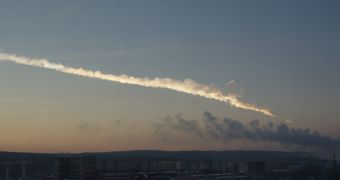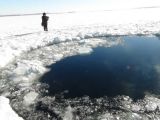The meteorite that struck early in the morning in central Russia is one of the biggest ever witnessed, at least the best documented. Data is still incomplete and there are some big differences in estimates, so the numbers may change in time.
The asteroid is estimated to have been 5 to 15 meters (16 to 50 feet) in diameter and weighed about 10 metric tons.
It entered the upper atmosphere at a tremendous speed, at least 15 km/s, or 34,000 mph.
Meteors like this actually hit the Earth every few years or so, but they tend to hit unpopulated areas or over the oceans that cover 70 percent of the planet.
As it hit, it slowed down considerably within seconds, to subsonic speed, leading to a huge increase in temperature and the flash of light reported by witnesses.
The violence of the impact with the air also most likely broke up the meteor into several pieces, probably several times over. This is why multiple explosions can be heard in the many videos that have surfaced.
These explosions generated the shockwaves that hit the ground minutes later. The shockwaves were so powerful that they shattered windows in many of the cities nearby, this is what caused all of the injuries.
The most recent estimates say as many as 1,200 people were hurt by glass or debris.
After the initial slowdown, pieces of the meteor continued to fall towards the ground for several minutes traveling at roughly the speed of a plane and slowing down in time.
Several possible impact sites have been discovered. One fragment created a crater some six meters (20 feet) across, near Chebarkul. Another may have hit a frozen lake, leaving a hole some 10 meters (33 feet) across in the thick ice.
The fireball was captured from space by a weather satellite. It will be a while before all of the data is pulled together and we get better estimates of the size and weight of the meteor, though the fact that there are so many recordings will help.
For reference, meteoroids are space rocks smaller than asteroids, meteors is what they're called when they enter the atmosphere and meteorites are what they're called if they make it to the surface of our planet.

 14 DAY TRIAL //
14 DAY TRIAL // 

